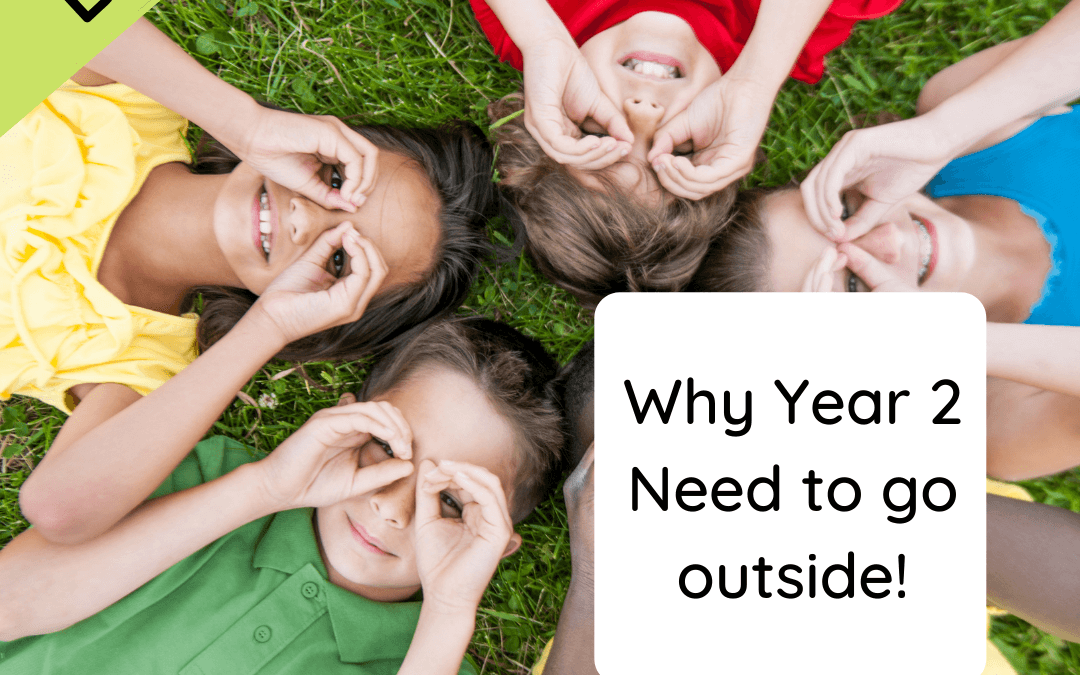Why Year 2 Need to go outside!
In the year of the 2020 pandemic, there was a huge push to encourage schools to use the outdoor space that they have to deliver lessons in. However, quality outdoor learning experiences still face several challenges, including revised risk assessments, funding restrictions and extra adult support for off–site visits. In the last decade there has been a move away from the outdoors, with fears over safety and the development of technology, which has led to problems, such as poor fine and global motor skills, balance, obesity and emotional regulation.
There has been a cultural shift in today’s society, where parents are working harder than ever and this fast-paced lifestyle places more demands on parental time and childcare. This can often result in children being booked into an array of after–school clubs, where they can ‘let off steam’ and then use screen time when they get home as ‘down time’ in which to relax. With the addition of curricular assessments to ensure children are ‘on track’ with their learning, there is a lot for parents, little ones and their educators to take in. This can present several problems and potential barriers to learning, such as anxiety, stress, emotional outbursts, aggression, frustration and apathy towards learning.
Enriched Environments!
Think back to your happiest moment from when you were a child learning something for the first time. Chances are, you were in an environment which nurtured and encouraged you; whether it was a conversation with a parent whilst being tucked into bed at night, playing pooh sticks in a stream to see what would float or sink, building dens and learning how to use what you have to attach your model roof safely. Even if your happiest childhood memories don’t include any of these, I can already guess that very few, if any of you, will say ‘completing a worksheet and getting a sticker’. Of course, those mini moments of pride stick with us and boost our self–esteem as we grow and encourage us to keep learning, but our most cherished memories are where we felt at ease outside the classroom.
Children learn by interacting with the environment around them. For example, if they are surrounded by four walls and rows of desks, they will soon learn that school and learning is ‘boring’ and they will disengage. However, if presented with a safe and stimulating environment which is ever–changing, whether it is the playground or the local park, they will be filled with curiosity and face challenges which will support a growth mindset, a crucial element in resilience and attitudes to learning.
Holistic learning and nurturing development.
Think about the last time you saw a truly happy 6 year–old. What were they doing? Chances are, they were doing anything but standing still, so learning needs to take place in an environment which allows for this. The outdoors allows learning to take place in line with each learners’ unique needs and skills which prepare them for the real world, giving meaning and motivation and increasing engagement in what they are learning.
Educators and parents should encourage as many opportunities as possible for their children to go outside, as it supports their learning in a holistic way which can help develop skills in the following:
Social: Through working with others, increasing self-esteem, sharing and taking turns, ensuring each other’s safety, decision making, an ability to cope with others and offer comfort if partner is feeling vulnerable.
Physical- Through movement, gross motor skills, balance and using different muscle groups, kneeling, climbing, using senses other than sight and vestibular stimulation (hanging, swinging, spinning etc).
Intellectual- Through decision making, problem solving and seeing different perspectives.
Communication– Through talking to each other and sharing ideas around upcoming obstacles.
Emotional- Developing empathy, respect for others, creativity, opening up and trust of other person.
Spiritual- Nurturing an appreciation for natural beauty, community, and sense of responsibility for the environment.
Supporting a love for learning
In an outdoor environment, a learner’s natural intelligence is developed and encouraged through curiosity, a love of nature, a sense of responsibility and the initiative to solve problems and spark enquiry. An example of this was when I had a class outside for PE; our class was interrupted by a pair of noisy seagulls and their babies. This sparked off discussions on why they were a different colour to the adults, how long until they flew the nest and if they migrated. This then further sparked off a series of science lessons, where the learning was led by the children based on the questions they were asking. We went on to learn about their average mileage, designed our own paper birds linking technology, looked at their diet and their food chain, which then led into designing machines and thinking of ways to reduce plastic in our oceans.
At the end of the day, educators are merely the ones facilitating the learning by providing a range of age-appropriate activities to guide the process. The children are at the centre of their own learning, which should be based through self-directed activities and hands on collaborative play. Doing lessons outside provides more space and a more calming environment for this in comparison to a classroom, where there’s barely enough space for children to get out of their seats and move around.
Social Interactions
The outdoors also presents learners with a variety of social situations that they would not have experienced otherwise, which supports social-cognitive development and empathy in young learners.
An example of this was when some of my Year 2 pupils brought me some leaves and were talking about how beautiful the colours were. They had been working together to pick them (supporting social and emotional development). We put them in the nature corner and the next day they came in to find a Tree Leaf Identification sheet and some crayons to try and take rubbings. I also provided them with some small rocks and Hessian and demonstrated the technique for bashing out the natural dyes. They became engrossed experimenting with the different techniques and then asked (communication) if they could make them into Christmas cards and talked about which prints they liked the best (reflective and cognitive development).
Nurturing engagement in lifelong learning and emotional wellbeing.
I often ask myself how many children would be suffering with obesity and too much screen time if they were engaging in outdoor activities regularly as part of their learning? How much less litter would there be on the ground if everyone learned from a young age that we need to look after our environment and understood the repercussions of our actions? What would happen if all schools had a safe space where children could go for a bit of breathing space to calm down when things are getting to them? Would children be more readily able to regulate and talk about these big emotions with their adults supporting them? Think of the skills that can be used and developed when learners are hooked into something that they can relate to the world around them!
Different lessons outdoors can promote different skills such as:
Orienteering – problem solving
Gardening – fine motor skills
Mud Pies – experimenting with different materials.
Water play – sensory stimulation
These are only a few named examples, however being outdoors enhances learning for all.
It can also provide educators with an insight as to what their learners need. I once had a class building bridges using loose parts and presented the learners with the new challenge of crossing the bridge with a blindfold. A child who had previously been very insular, angry and frustrated in the classroom came out of his shell and, on seeing his classmates unsettled by the blindfold, patiently and calmly guided them across the bridge, supporting them (supporting social and emotional development). It soon became clear that his aggression and frustrations towards his classmates had mainly manifested because of the overstimulation inside and by being outside he was able to find some release, resulting in better emotional regulation. By removing these barriers, he was more motivated to engage with further learning (reflective and cognitive development).
Learning outdoors removes a lot of barriers for your reluctant readers and writers and is inclusive in practice where learners have meaningful practical lessons beyond pencil and paper, igniting enthusiasm for lifelong learning.
Take it outside!
In recent years, Outdoor Learning is something which has often been overlooked and has been viewed as a ‘nice to have’ feature by many already over-stretched practitioners rather than an integral learning and teaching approach that nurtures pupils across all stages.
However, you do not need a fancy outdoor classroom to deliver quality learning outside, nor do all your lessons need to be outside 100% of the time! Even if your school is in a concrete jungle, you can jazz it up by making a few planters out of old tyres and some loose parts play kits. One of my favourite resources has been the ‘stick box’, where an inner-city school had a trunk of sticks and chalk to bring out for outdoor lessons as they had no trees nearby. Have a think about a lesson you would normally deliver inside, then ask yourself ‘Why inside? How can I take it outside?’ Write down any of your barriers – whether it’s weather or resources – and, most of the time, there are solutions to these problems (e.g. wrap up warm, start off small with what resources you have).
Spending any time outdoors is always beneficial for your own and learners’ mental and physical health.
So go on, get outside and surprise yourself and your learners!
There is so much to gain!
Top Tips for Taking your class outside:
Start small; use the outdoors to spark off as stimulus for a lesson or to explain a concept. This will have your learners hooked with the change of scenery.
Dress for the weather! When going outside, talk with your children about what the weather is like outside; share with them how long you will be out for and talk about what they think they might need. Schools and nurseries – you might want to have a prepared list of outdoor clothing for each season and have children arrive wearing their outdoor clothing for different weathers.
Risk assess any sites beforehand, especially if going out of school grounds. Log them and assess how these can be minimised.
Set a clear boundary and comeback call to gather class back up for teachable moments and at the end of the lesson (E.g. a whistle or a bird caller.)
Ask local wood yards or garages for old tyres and pallets which you could use for loose parts play or planters. Usually, they are pretty thrilled to get rid of them! You could also integrate a woodland sponsored walk into your sessions to fundraise for resources!
(From a teacher’s perspective, look at your curriculum and what needs to be covered that term. Split your weeks so that you have at least one session outside a week. Change up the curricular area! It doesn’t all need to be maths and science; it can inspire art and literacy as well! Think, ‘how can I take this outside?’ or ‘how can the outside spark off this lesson?’
Have a ‘grab–and–go’ kit made up with loose parts, chalks, some cuddly toys, ropes, a tarp and a first aid kit. The possibilities are endless with these resources!
Going off site? Have a laminated emergency contingency plan and a fully stocked first aid kit. You might need it!
Use play to promote teamwork and problem solving.
Don’t restrict Outdoor Learning to just the early years! Make it a whole school learning and teaching approach and see a whole different side to your learners!
Fancy giving it a go?
Try taking things outside with this muddy puddle Year 2 literacy lesson!
https://themuddypuddleteacher.co.uk/year-2-poetry-sunny-day/
Looking for further inspiration? Here are some links with some great resources and outdoor tips.
https://www.bilbroughcc.co.uk/ – Links to farming and where food comes from.
https://creativestarlearning.co.uk/ – great blogs with tips, ideas and lessons. Links to potential funding as well.
https://www.field-studies-council.org/ – Freebies and good to support survey and field studies work.
http://geocachingforschools.co.uk/: Great resource linking to maps and journeys.
https://getoutside.ordnancesurvey.co.uk/ – Route ideas and tips to get outside.
https://www.johnmuirtrust.org/john-muir-award – Another great award scheme. Our school has also used this as a progression linking with skills for life. Good starting point as an Outdoor Learning progression.
Lesson ideas across a range of age groups. Links to the Scottish and English curriculum very nicely.
https://themuddypuddleteacher.co.uk/what-is-muddy-puddle-teacher-status/ – 100s of free resources, ranging from babies to age 11. Linked to the curriculum and uses only natural and upcycled resources. Free Blog. Free CPD Podcast. Training also available.
https://themuddypuddleteacher.co.uk/essential-outdoor-activities-with-kids/A great blog for parents to help join in with getting outside in all weathers.
https://themuddypuddleteacher.co.uk/
Remember that you can train with us and access the full range of our resources, including phonics session plans and work schemes for only £49.99 for the full year.
However, if that is not for you for now, try our FREE life-time trial here, giving you access to hundreds of resources or try some of these below:
https://www.nationaltrust.org.uk/50-things-to-do Our school has used this as a progression linking with skills for life. Good starting point as an Outdoor Learning progression.
https://www.outdoorlearningmadeeasy.co.uk/
Lots of great ideas to get the children outside and active.
https://outdoorclassroomday.org.uk/ Takes place in May. Lots of free resources all year round.
https://www.owlscotland.org/ – Great network of outdoor professionals and lots of resources.
https://www.rhet.org.uk/- Lots of resources linking to food and farming lesson.
https://www.rspb.org.uk/fun-and-learning/for-teachers/lesson-plans-and-supporting-resources/– Take part in the Big British Bird Watch and learn about biodiversity in your local area!
https://www.sustainablelearning.com/ – Free and easy to download ideas.
https://www.treetoolsforschools.org.uk/menu/ –
Free trees and planting packs, also ideas that link to the curriculum.
https://www.twinkl.co.uk/– Offer a range of ideas to get the children outside and active.
https://www.wildlifetrusts.org/– 30 days Wild Challenge with lots of helpful ideas. Good home learning tasks.
By Muddy Teacher Jess


